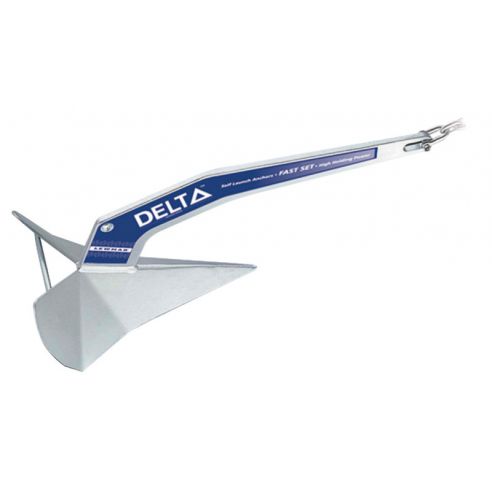- Material
- Galvanized steel
- Anchor type
- Delta
- Backdrop
- Mud Rocky Sand
- Reclosable
- No
- -10%
Its strengths are: - the exceptional hold with any bottom (including kelp); - the quickness to regain hold when it tends to be dispatched by rotation of the boat around the anchor point; - the true ability to increase hold as the wind increases. Tests on several occasions confirm that the Delta is the anchor with the best grip relative to weight. Guaranteed for life against breakage. Lloyd Register certification as a high holding power anchor.
Prodotti alternativi
Product Details
Description
Peso 4 kg. - Dimensioni 514 x 228 x 387 x 210 mm. Catena raccomandata 44748 mm. Per scafi fino a 7 mm.
Peso 6 kg. - Dimensioni 595 x 263 x 450 x 241 mm. Catena raccomandata 44748 mm. Per scafi fino a 9 mm.
Peso 10 kg. - Dimensioni 695 x 308 x 526 x 283 mm. Catena raccomandata 8 mm. Per scafi fino a 11 mm.
Peso 16 kg. - Dimensioni 812 x 360 x 614 x 334 mm. Catena raccomandata 8 mm. Per scafi fino a 13 mm.
Peso 20 kg. - Dimensioni 877 x 389 x 663 x 361 mm. Catena raccomandata 10 mm. Per scafi fino a 15.5 mm.
Peso 25 kg. - Dimensioni 945 x 417 x 713 x 384 mm. Catena raccomandata 10 mm. Per scafi fino a 17 mm.
Peso 32 kg. - Dimensioni 1026 x 455 x 774 x 417 mm. Catena raccomandata 10 mm. Per scafi fino a 18.5 mm.
Peso 40 kg. - Dimensioni 1099 x 489 x 835 x 446 mm. Catena raccomandata 10 mm. Per scafi fino a 20 mm.
Peso 50 kg. - Dimensioni 1175 x 520 x 890 x 479 mm. Catena raccomandata 12 mm. Per scafi fino a 23 mm.
Peso 63 kg. - Dimensioni 1278 x 568 x 673 x 518 mm. Catena raccomandata 12 mm. Per scafi fino a 26.5 mm.
About Lewmar
Buying an anchor is not always an easy task. There are so many types, they vary in
Clearly, a 12-meter sailboat is not going to have the same needs as a fishing boat or yacht, so during the purchase you should always keep an eye on both the size and the bottom that the boat will face.
How many types of anchors are there?
TheAdmiralty strain anchor is the one in the common imagination. It is a highly efficient accessory but little used in recreational vessels because it is heavy and bulky. Its validity, however, derives precisely from its significant weight and the position of the flukes, which make it excellent for various types of seabed from sandy to seagrass-rich. For a yachtsman, it is best taken as an anchor of hope.
The plowshare anchor, on the other hand,
From 1972, on the other hand, we get the Bruce anchor, named after the naval engineer Peter Bruce, which works very well in all bottoms except particularly muddy or rocky ones, the only flaw being stowage, which is made particularly complicated because of its shape.
Another still good one is the umbrella one designed specifically for smaller boats as a small, foldable lightweight tool (just like an umbrella), which, however, has some shortcomings in terms of holding except in particularly rocky bottoms.
Usually all shipyards rely on multi-purpose anchors forbasic equipment, then leaving free choice to the boater for possible change dictated by his habits and the seabed needs he expects to face. As a general rule of thumb, flat and large, stump or bruce anchors work on gravelly and sandy bottoms, while thin flukes, or croup and umbrella anchors for example, are designed for rocky or muddy bottoms.
The advice, however, is to always equip oneself with a respect anchor/safe/reserve. In fact, all boaters, with the exception of those who own a really small boat, should always have two anchors with different characteristics on board. Assuming that you own a Bruce anchor and that the bottom where you want to lower it is predominantly rocky,
Lewmar



